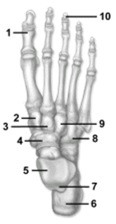 This figure shows the bones of the ankle and foot. The bone indicated by number 4 is the
This figure shows the bones of the ankle and foot. The bone indicated by number 4 is the
A. intermediate cuneiform.
B. lateral cuneiform.
C. navicular.
D. medial cuneiform.
E. talus.
Answer: C
You might also like to view...
Answer the following statements true (T) or false (F)
1. Cellular respiration is an anabolic process. 2. Glycolysis is a series of six chemical steps, most of which take place in the mitochondria. 3. Glycogenesis begins when ATP levels are high, and glucose entering cells is phosphorylated to glucose-6-phosphate and converted to its isomer, glucose-1-phosphate. 4. All athletes require diets high in protein and calories in order to perform and to maintain their muscle mass. 5. In order for amino acids to be oxidized for energy, the amine group (NH2) must be removed.
Which of the following is most life threatening?
A) Ventricular flutter B) Atrial flutter C) Atrial fibrillation D) Ventricular fibrillation
The pH of chyme is usually 7.5-8.8.
Answer the following statement true (T) or false (F)
Whenever an amino acid is used for cellular respiration, it enters the pathway at the intermediate stage.
Answer the following statement true (T) or false (F)